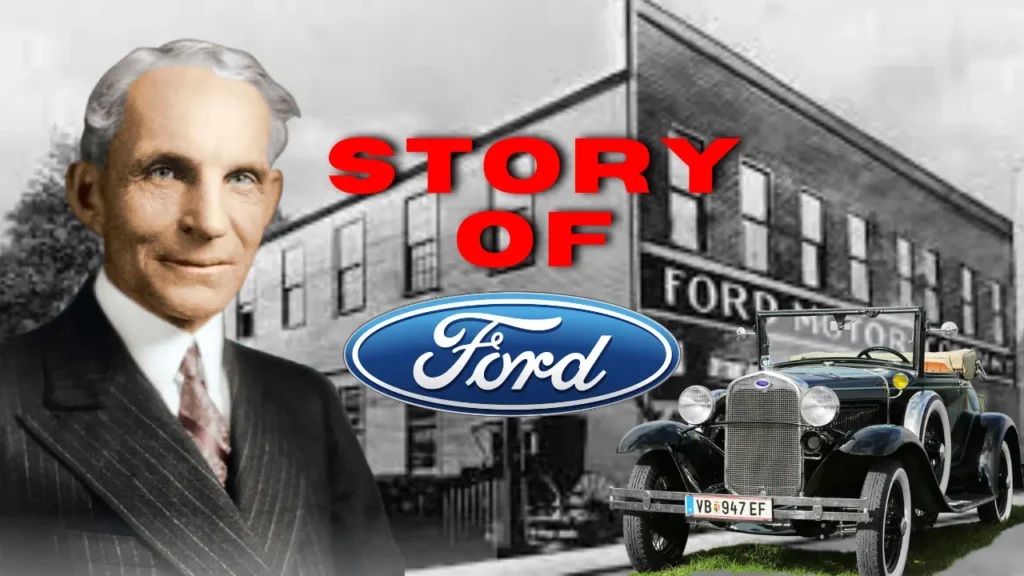Imagine a world without cars. It’s hard to conceive. Yet, before Henry Ford, automobiles were luxury items accessible only to the wealthy. Ford revolutionized transportation, making cars a necessity for millions. His journey from a humble farm boy to the creator of one of the world’s most iconic brands is a testament to the power of innovation, determination, and a relentless pursuit of a dream. In this blog post, we’ll delve into the life and legacy of Henry Ford, exploring his groundbreaking inventions, his tumultuous business ventures, and his enduring impact on the world. So, buckle up and join us as we ride through the life of the man who put the world on wheels.

A mechanical genius who never made it to high school but one who would eventually create the world’s most important automobile. His vision was so strong that few of his contemporaries even believed in it; even after generating billions of dollars for his company, he had to wrestle control away from investors to have his way now, though his name is synonymous with Carr. He is remembered as one of the greatest innovators of all time. This is the story of Henry Ford.
Table of Contents
Chapter 1: From Bicycles to Engines
Henry Ford was born in 1863 on a farm in southeastern Michigan. His parents were both second-generation immigrants from England and Belgium. Henry grew up in a modest family with four siblings and attended school until the eighth grade, dropping out before finishing high school. However, this didn’t mean his brain wasn’t active. As a young boy, he would take apart machines to understand how they worked, which earned him a handful of jobs fixing family members’ watches. His greatest fascination, though, was with road engines, which were revolutionary at the time.
Meanwhile, his father was preparing Henry to take over the farm. Henry enjoyed the mechanical aspects much more than the manual labour, leading him away from farm life and into the city of Detroit to take on an apprenticeship as a machinist. Over the next half a decade, Henry became masterfully knowledgeable about machinery, especially the Westinghouse portable steam engine, which allowed his family’s farm to gain the benefits of steam power. This led to a job with Westinghouse as a serviceman, repairing faulty and broken-down units.
Henry married Clara Bryant in 1888 when he was 25 years old. They returned to the family farm for less than a year before Henry became restless. His real passion was for innovating products of his own. Ford left Westinghouse to work at Edison’s company in Detroit, a much higher-paid position as an engineer. This is where he would gain his greatest inspiration.
Privately, he began working on a two-cylinder, four-horsepower motor that powered his very first motor car, completed in 1892. It utilized a countershaft and chain to generate speeds up to 20 miles per hour. Despite never going to university, he was proving himself to his superiors at Edison Illuminating Company and climbed the ranks quickly. Within two years of working there, he was promoted to chief engineer.
In a small workshop at the back of Henry and Clara’s house in Detroit, he spent all his free time working on an automobile, believing that gas power was the future rather than electricity. By 1896, he had developed his first self-propelled vehicle, which he named the quadricycle. It was powered by pure ethanol and was essentially a horse carriage with four bicycle wheels and an engine powering the rear wheels, steered by a lever. The first Ford quadricycle was sold for two hundred dollars, equivalent to almost seven thousand dollars today. This was Henry’s first motor car sold, but it still had a long way to go before it became the Ford we know today.
Chapter 2: Going Alone
Working at the Edison Illuminating Company helped Henry Ford fund his first automotive experiments. In 1896, after building his quadricycle, he was introduced to Thomas Edison, who praised Henry’s innovation. By this time, he had made a second model. Edison’s recognition was a huge motivation for Henry to gamble on himself. With the tick of approval from one of the time’s greatest mechanical minds, Henry felt confident going alone and leaving the company.
Edison offered him one thousand nine hundred dollars a year to stay, almost double the average salary at the time and equal to nearly seventy thousand dollars today. But Henry believed in his vision. It was a considerable risk, and Henry would need to attract much more investment than he had in savings. He secured the backing of an investor named William H. Murphy after taking him on a 60-mile test drive in one of his vehicles. With that, the Detroit Automobile Company was born.
Henry rolled out the company’s first product, a delivery wagon, but his investors had different ideas. They wanted to diversify the product range and scale up the operation against Henry’s wishes. The result was severely manufactured cars at a higher price than Henry wanted. And so, in late 1990, less than a year after founding the company, he left instead.
Henry joined forces with friends, working nonstop to build one of the most iconic automobiles of his lifetime. Aided by some former stockholders who had followed Henry after he left, the team constructed a two-cylinder, 26-horsepower lightweight racer. Henry drove the car to win a race at Gross Point against a 40-horsepower machine, a massive feat at the time. This made Henry famous in the automobile world. He was an up-and-coming engineer, and his success on the racetrack was enough to earn him the backing of several other former Detroit Automobile Company stockholders who gathered behind him once again to form the Henry Ford Company in 1901.
But this, too, was an ill-fated enterprise. Once again, they found their visions drastically diverging. By now, Henry wanted to focus on building a four-cylinder racing car, while the rest of the investors wanted a smaller, lightweight, and affordable vehicle to roll out to the mass market. For the second time, Henry parted company and took his name with him. The existing company was rebranded as the Cadillac Automobile Company, while Henry went on to forge his path, with the value of his name now at an all-time high.
Chapter 3: First Models
In 1902, working with a bicycle racer named Tom Cooper in a workshop in downtown Detroit, Henry built the Ford 999, which had a massive engine and produced up to 100 horsepower. The 999 won the Manufacturer’s Challenge Cup, drawing the interest of Alexander Malcolmson, a wealthy Detroit coal dealer. The two struck up a partnership, and the following year, Ford and Malcolmson Incorporated with the name Ford Motor Company.
Henry Ford received the most shares, tied equally with Malcolmson, followed by a coal maker named John S. Gray and 12 other stockholders. Even in their first year, the Ford Motor Company was a roaring success, recording 37,000 in profits after just months of business. But tensions inside the operation began to emerge. Despite the record profits and dividends being paid to shareholders, once again, Henry found himself fighting with stockholders about the company’s future.
His close partner, Malcolmson, found himself clashing with Henry, but Henry would not let this operation slip out of his control as his two earlier companies had. He rallied the support of John S. Gray and other investors, coordinating an attack to freeze Malcolmson out of the company. Malcolmson was forced to sell his shares to Henry, and later that year, he died, making Henry Ford the undisputed leader of his company for the first time, at least for now.
The company secured early funding in 1903, but it was all hedged on the success of the Ford Model A, released the same year. The Model A was a two-cylinder, 16,068 CC, 1200-pound automobile with a top speed of 28 miles per hour. The price was set at 750 dollars, which would be twenty-six thousand dollars today. Coated with a shiny red on its wooden frame, the Model A was marketed as the most reliable machine in the world.
The Model A turned a profit, but 750 dollars was a higher price than its rival, the Oldsmobile Curved Dash. Over the next few years, Henry would take years, and Henry would take more than a dozen and a half models to find the sweet spot for consumers.
Henry released other models like the six-cylinder Gentleman’s Roadster, the Model K, and a front-engine 15-horsepower Model M. But undoubtedly, the most successful was the Model T, which Henry Ford developed in 1908. This model would catapult the company to global industrial success. First, he needed to make a workforce fit for the task.
Chapter 4: The Assembly Line
Henry Ford was constantly thinking about how he could lower the cost of production. One half was materials and logistics, but the other half was creating a more efficient workforce. With the Model N, different car components were laid out on the factory floor and dragged along the floor on skids as each department worked on it. This was an uphill task, but improving efficiency was a game of trial and error that would soon lead to Ford’s greatest successes.
This was designed to divide labour into hyper-specialized jobs. With the Model T, Ford took this to an unprecedented level in history. The car’s production was broken up into 84 different steps, and workers were trained only for one step. He brought Frederick Taylor as a consultant rather than a business management consultant. Taylor was an expert in movement and industrial efficiency. He systematically broke down each workplace component to make it a scientific operation.
One of Ford’s most significant technological innovations in the factory was a moving chassis assembly line, which eliminated manually moved skids and allowed for a robotic-like workforce. By the following year, a belt pulled components at six feet per minute. And when the pace increased, so too did production. Incredibly, a brand-new Model T could be assembled in just 90 minutes.
Every part of the car was designed for speed and production. Whereas earlier Ford models were available in different colours, the Model T was only produced in black. Through testing, Henry found that only the Japanese black varnish could dry quickly enough to keep up with the pace of production.
He was as interested in innovating the workforce as he was in automobiles. He needed to improve the working environments to match his new machinery and ever-growing car production. Workers were leaving his company in droves, complaining about the repetitive, tedious nature of the assembly line work. Before, they had constructed entire vehicles, but now they would work on only one daily task.
To maintain a stable group of workers and avoid having to rehire and retrain consistently, Ford offered the most competitive rate in the industry: five dollars a day for eight-hour workdays. This was more than twice the going rate with fewer work hours in the day. In the context of widespread unemployment, this attracted tens of thousands of workers to swarm the Model T plant in Highland Park, desperate for jobs. A decade later, Ford became one of the first companies to introduce the 40-hour, five-day workweek, finding that employees became more efficient.
Ford’s philosophy also included giving his workers enough to afford to buy the products they were creating, thereby creating even more customers. Henry Ford said publicly, “We believe in making 25,000 men prosperous and contented rather than following the plan of making a few slave drivers in our establishment multi-millionaires.” But he admitted that it was instituted to boost productivity. Having workers around for fewer hours but working harder increased their output. Fordism soon spread to other industries because it worked.
Chapter 5: Fighting for Success
Immediately after the launch of the Ford Model T, the company received 15,000 orders, signalling the future the company was in for. But even Henry couldn’t have imagined how huge their success would grow. When production ended 13 years later, 15 and a half million Model Ts were produced, and it still ranks as one of the best-selling cars of all time. Ford had become the most prominent American car manufacturer, and at times, an estimated 50 per cent of all cars in the country were Model T’s. Of course, this translated into huge profits for the company, too.
Three years after its release, the Ford Motor Company had a capital surplus of a staggering 60 million dollars, equivalent to 1.6 billion dollars when adjusted for inflation.
But this great success brought problems that were all too familiar. Again, Henry Ford’s vision conflicted with his stockholders. This time, though, it would be immortalized in law. John Francis and Horace Elgin Dodge, who together owned 10 per cent of the company, the largest after Henry, opposed Henry’s investments in new plants and the plans to end special dividends. Seeing the tens of millions of dollars accumulate, the Dodge Brothers wanted cash in hand rather than a long-term investment. The Michigan Supreme Court agreed, awarding them 19 million dollars in dividends, half a billion today.
Henry was enraged. His vision for more excellent production facilities and global domination was being stunted. He threatened to leave the company and set up another unless he could gain complete control of the company. Henry paid 125 million dollars today, over 2.24 billion dollars. He was forced to take out loans to raise the money. Success was necessary, and his entire net worth was tied to the company. However, it meant Henry Ford controlled his company almost 20 years after his first business venture.
Chapter 6: A Dirty Business
Under Henry’s undivided leadership, the company rapidly expanded, acquiring The Lincoln Motor Company and moving to the Brazilian, German, and Soviet markets. Some of these markets were marred. Henry collaborated closely with the Nazi government, ordering the removal of Jewish managers in their German plants and aiding the production of Nazi machinery. On the eve of World War II, he even refused to build aeroplanes for the Allies, even when the German plant was taken over by Nazi management. Ford maintained the majority of profits.
When war did break out in Europe, though, Henry was on the brink of death, and his son, Edsel Ford, was in charge. In contrast to his father, whose official stance was to remain neutral, Edsel chose to join the war effort and produce hundreds of thousands of tanks, trucks, jeeps, and aeroplanes for the American forces.
To everyone’s surprise, though, Edsel died before Henry in 1943 from stomach cancer. When Henry Ford died in 1947, his net worth was equal to 200 billion dollars, making him one of the wealthiest men ever to live. But his company was a different story. Ford was passed on to the next generation. Henry Ford II, also known as Hank the Deuce and the founder’s grandson, had inherited a sinking ship, which was losing 10 million dollars each month, equivalent to 200 million dollars today. With the end of the conflict in Europe, factories had been decimated along with communities, workers, and vital infrastructure.
Henry II remade the company’s executive level, replacing management with talent from elsewhere, including elite members of the Army Air Force’s statistical team. Under this leadership, Ford expanded aggressively and established itself as a global financial player, introducing the iconic 1949 Ford. After negotiations with Ferrari fell through to acquire the Italian company, Ford developed the GT40 to bolster its presence in motorsport, which went on to dominate the 24 Hours of Le Mans race.
The GT line heralded an era of powerful sports cars for Ford, called Pony cars, including the iconic Ford Mustang. The company went public in 1956, raising 7 billion dollars. When Hank the Deuce passed away in 1987, it was the first time the company fell out of the direct leadership of the family.
History of Ferrari: The Success Story of Ferrari’s
The Rolls-Royce: Success, History, Case Study
Audi Success Story: Case Study of Audi and Future of Luxury Mobility
Mercedes-Benz: World’s First Car Success Story
Chapter 7: The Next Generation
Ford celebrated its 100th anniversary in 2003, and the 21st century marks a bold new era with the company turning to EcoBoost engines and developing gas-electric hybrid SUVs. The company also underwent a significant restructuring through consolidation, job cuts, and more targeted product selection. The Ford Motor Company is worth an estimated 125 billion dollars, generating a 17 billion profit in 2021.
Since 1999, Henry Ford’s great-grandson, William Clay Ford Jr., has been the company’s executive chairman. He is the latest link in a family dynasty that began 120 years ago from a small workshop in Detroit. Henry Ford’s impact on society was enormous. He kicked off a revolution in the automobile industry, permanently changing how cars were manufactured and how enterprises worldwide organized themselves. Ford turned determination, hard work, and uncompromising belief in himself into one of the most successful companies the world has ever seen.
Henry Ford’s story is a testament to the American Dream. From a humble farm boy to the industrial titan who shaped the modern world, his journey is one of innovation, determination, and unwavering belief in his vision. His legacy extends beyond the automobile industry, impacting everything from manufacturing processes to workplace culture.
As we reflect on Ford’s life and work, we can’t help but be inspired by his ability to turn a dream into a reality. So, the next time you hop into your car, take a moment to appreciate the man who made it all possible.
I hope you got the answers to your questions and queries like – Henry Ford’s success story, Ford’s success story Henry Ford, Henry Ford’s invention, What Henry Ford is famous for, Henry Ford’s education, Interesting facts about Henry Ford, Where Henry Ford went to school.
What are your thoughts on Henry Ford’s legacy? Do you believe his innovations have positively or negatively impacted society? Share your thoughts in the comments below!










